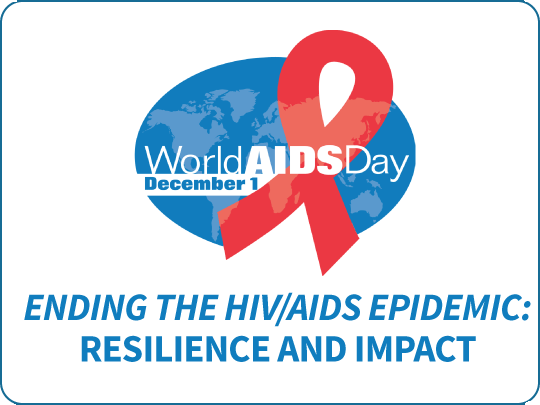 On December 1, 2020, people and organizations around the world will observe World AIDS Day, to help bring awareness to the HIV epidemic. According to Hiv.gov, those observing the day will “endeavor to increase HIV awareness and knowledge, speak out against HIV stigma, and call for an increased response to move toward Ending the HIV Epidemic: A Plan for America.”
On December 1, 2020, people and organizations around the world will observe World AIDS Day, to help bring awareness to the HIV epidemic. According to Hiv.gov, those observing the day will “endeavor to increase HIV awareness and knowledge, speak out against HIV stigma, and call for an increased response to move toward Ending the HIV Epidemic: A Plan for America.”
HIV – human immunodeficiency virus – is “a virus that attacks cells that help the body fight infection, making a person more vulnerable to other infections and diseases.” The disease is most commonly spread through unprotected sex or the of sharing drug equipment like needles, although it can be spread by contact with other bodily fluids as well.
AIDS – acquired immunodeficiency syndrome – is “the late stage of HIV infection that occurs when the immune system is badly damaged because of the virus.” Luckily, most people in the U.S. do not develop full-blown AIDS due to the availability of HIV medication which stops the progression of the virus. Without these treatments, those with AIDS have a typical life expectancy of three years.
First observed in 1988, World Aids Day has had many different themes. This year, the theme is “Global Solidarity, Shared Responsibility,” according to UNAIDS, an organization focused on ending AIDS worldwide.
UNAIDS says that the way COVID-19 is handled will directly impact the AIDS epidemic. “In many respects, the defeat of AIDS as a public health threat depends on how the world responds to COVID-19,” they write on their website. “The leadership and engagement of communities, instrumental in the success of the AIDS response, has also been key in responding to COVID-19. We have seen countless examples of how community activism and solidarity have, once again, been paramount in providing people affected by HIV with information, services, social protection and hope. However, such solidarity cannot be the sole responsibility of communities. Governments, donors, faith leaders, civil society and each and every one of us need to contribute to making the world a healthier place.”
According to National AIDS Trust, there are an estimated 38 million people around the world who have HIV. While only discovered in 1984, at least 35 million people have died of HIV or AIDS since then. Getting tested is the only way to discover an HIV infection, and it is imperative to start treatment early.
To find a testing center near you, you can use the search tool at AIDSVu, or contact your primary care physician.
For local information and support, visit the Valley AIDS Information Network.
By Kyra Young
Do you have a story for The Advocate? Email editor@corvallisadvocate.com


